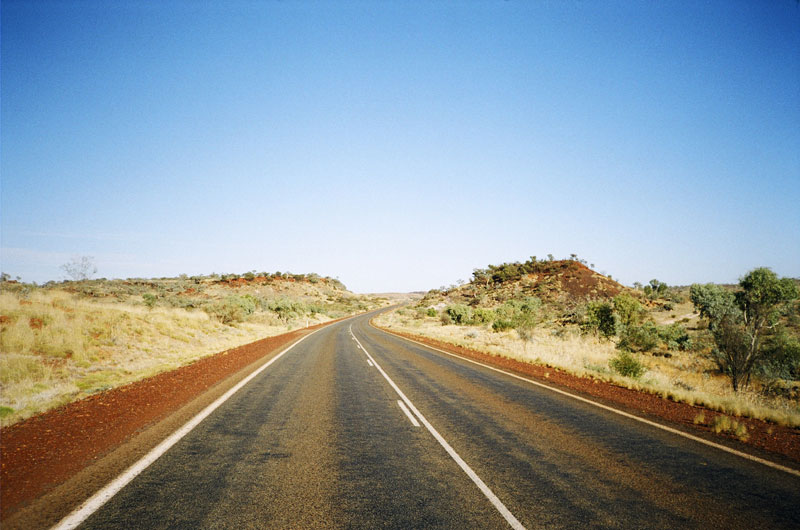Newman: Radio Hill Lookout
Radio Hill Lookout
Newman, WA
April 8, 2005
5:00 pm
G'day mates,
How ya goin'?
I'm just out of town, up on Radio Hill Lookout and I'm looking down at wee Newman below (pop 3600). In actual fact, Newman does have one 18 hole golf course.
Newman is the capital city of Pilbara Shire (county), purportedly the largest shire in the world. Considering that Pilbara is the largest shire in WA, and WA is the largest state covering about one-third of the land mass of Australia, this place is BIG!
The guidebook says it well:
"The Pilbara is a vast arid region of land with a brittle husk and a heart of iron-ore. It's this dusky dirt below the surface that has gigantic machines tearing into the ranges, ridiculously long trains rolling through the desert and comfortable towns propped seemingly in the middle of nowhere."
"Stretching along the coast from Onslow to Port Hedland are the transport towns that ship mountains of iron-ore overseas. Inland are the machines, the mines and the neat company towns that service them. Also inland are the land's natural scars, in the rugged gorges on Millstream-Chichester and Karijini National Park, which also contain waterfalls and plunging waterholes."
The view from Radio Hill is boundless in all directions. Running north and south the slim black "bitumen" slicing through the hills and flat-lands invites me for another day's drive northwest to the Hamersley Range and Karijini National Park.
To the east the land grows dark. Large clouds are forming but I don't think it's raining out there. Nevertheless, I see a rainbow - an Aussie rainbow. Not long and slim, but large and broad.
To the far west the sun is nearing the peaks of the Pilbara and Mt. Newman, named for the cartographer who first trekked across this "brittle husk with a heart of iron-ore."
This morning I visited Mt. Whaleback iron-ore mine. In a word, massive or if your prefer, enormous. Take your pick. Measuring 5 km long (3 mi) and 1.5 km wide (1 mi), it is the largest open pit mine in the world. From the edge of the pit, the trucks and excavating equipment at the bottom look like miniature toys.
Everything is on a massive scale. After blasting, excavators scoop up to 60 tons of iron-ore and load it into haul trucks that can carry as much as 240 tons. The ore is transferred to the primary crusher. The crusher breaks down boulders of up to 1.5 metres in diameter into rocks about the size of a soccer ball. It is then transferred to a secondary crusher where it is broken down into grapefruit-sized lumps.
Eventually, two trains a day up to 7 kms long with up to eight locomotives will carry a mass of 80,000 tons of high grade ore over a distance of 275 kilometres from mine to port, where it is shipped to the steel plants of China, Japan, South Korea, Taiwan, England, Germany, Turkey, France and Romania.
Think about it: Your Honda, Toyota or Mitsubishi, KIA or Dihatsu, Jag, Beemer, Benz, Peugeot, or Dacia...the vehicle you are driving today may have been born in the pit at the bottom of Mt Whaleback in the Pilbara in Western Australia.
OK. Let's do a little more geography.
Australia is the world's sixth largest country. Area of 7,682,300 sq km. Over 75% of the continent is considered "Outback." The beer may be better in Germany, the coffee the same in England, and the weather in Ireland may not be as fine, but all three of those countries would fit nicely into just Western Australia - with room to spare.
There are eight states. Can you name them?
Queensland, New South Wales and Victoria in the east. Northern Territory and South Australia in the middle. Western Australia. The island of Tasmania. And also in the east, tiny ACT - Australian Capital Territory. So, what's the capital?
Sidney? Sorry! Maybe Melbourne? Mmmm...Mmmm. Brisbane? Bzzzz. Perth? Nope. Perhaps London? Just kidding. Washington DC? Oops. Well, can you tell me? CAN you?
OK. A little humour:
The large Black Swan is the state bird of Western Australia. It may as well be the large Black Fly. I sprayed on my DEET but they still hovered and buzzed, seeking moisture from my lips and eyes and ears, and neck and sweaty shirt.
I bought the local "Tropical Strength" insect repellent. "Maximum strength DEET as used by the armed forces. May assist in the minimization of Ross River Virus (whatever that is) and malaria." This stuff doesn't work either. You know what this Water Resistant Gel is called? "WACK OFF!" No kidding. Fair dinkum.
I finally bought a fly net. $6.00. Fits over your hat and around your head down to your shoulders. Works good. Out on a trek, one bloke offered me $100.00.
When I first arrived I thought everyone was waving at me. Later I realize that they were shooing away the flies. It's called the "Aussie Salute!"
And finally, here in the dry Outback, fire is a real concern. Signs everywhere say, "Prevent Bush Fires." And can you imagine? Some vandals had the effrontery to paint over the word "fires." Outrageous.
Cheers mates.
See ya,
Jan
PS I will be traveling in Australia until 27 April. If you have never made a telephone call below the equator, or if you miss the sound of my Aussie accent, please call my mobile at 61-437-889-397. Twelve hours time difference between here and EDT. No worries.

